 |
 |
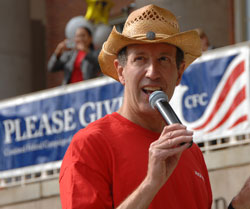
|
|
Dennis Askwith, Program Analyst, National Heart, Lung, and Blood Institute, National Institutes of Health
|
1. I chose this career because...
2. My typical workday involves...
3. What I like best/least about my work...
4. My career goals are...
5. When I'm not working, I like to...
|
|
1. I chose this career because...
|
Back to Top

|
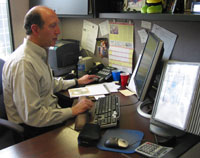
|
|
Dennis spends time at his computer, assessing current institute programs and identifying ways to improve their implementation.
|
I chose to become a program analyst because it has allowed me to work on a wide variety of challenging public health problems over the past 30 years. These have included family planning, maternal and child health care, migrant health care, health care utilization and quality, drug abuse, and currently heart, lung, blood, and sleep research. Being a program analyst fits my personality type – that being predominantly an analyzer, as contrasted to the other three personality types identified as controller, promoter, and supporter. These four personality types make up the acronym CAPS, based on a research study about personal styles of behavior. You can take the CAPS Personal Style Inventory to ascertain your predominant personal style at www.tech.purdue.edu/ols/courses/ols388/krug/caps.doc.
As an undergraduate, I studied economics, government, and English, all of which have been useful in my career choice. In graduate school, I studied health policy and management, from which I acquired many concepts and tools directly related to my work as a public health program analyst.
College Education
- Artium Baccalaureatus (A.B.) or Bachelor of Arts (B.A.), English, Cornell University (http://www.cornell.edu/), Ithaca, New York
|
|
2. My typical workday involves...
|
Back to Top

|
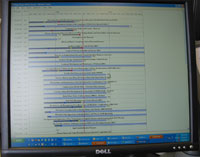
|
|
Dennis uses a software program to track the progress and duration of major projects funded by the institute
|
My typical workday covers a range of activities related to strategic planning (what do we want to do) and tactical thinking (how do we want to do it) about the work of the National Heart, Lung, and Blood Institute (NHLBI) (http://www.nhlbi.nih.gov/index.htm).
On the strategic side, we have recently finished developing a Strategic Plan to guide our efforts over the next five to ten years. (http://apps.nhlbi.nih.gov/strategicplan/). On the tactical side, I am in charge of designing and maintaining an Initiatives Tracking System that keeps tabs on the dozens of Requests for Grants Applications and Requests for Contract Proposals that we have issued (http://www.nhlbi.nih.gov/funding/inits/index.htm#rfa) or are thinking about issuing, as a means to achieve the goals of the Strategic Plan.
About two-thirds of our three billion annual budget is spent on investigator-initiated research and one-third is spent on institute-initiated research. This latter portion is the focus of program analysts who identify the most urgent public health needs. We then work with program staff to develop promising programs to address these needs.
Program Analysts Collaborate, Research and Write Reports
The NHLBI, with its broad mandate, collaborates with approximately 100 public interest groups (http://www.nhlbi.nih.gov/public/grouplist.htm) representing particular diseases, conditions, and patient populations. Several program analysts in my office work with these groups to assure that their voices are heard and considered by the Institute as we plan our research agenda.
Some years ago I was the chief of a branch of five program analysts dedicated to researching and writing reports on the amount and nature of the research on particular topics, such as obesity or children or rare diseases that we support “extramurally” at universities around the country and conduct “intramurally” here in Bethesda, MD. With advances in the field of artificial intelligence and knowledge management, we are now transferring this type of analysis from human beings to sophisticated informatics software programs (http://era.nih.gov/Docs/Knowledge_Mgt_Morris_10-09-03.pdf). Still, program analysts are required to keep on eye on and fine tune the algorithms used by the software programs.
NIH Program Analysts Evaluate Programs to Improve Implementation
The law under which NIH operates requires that we spend one percent of our budget every year on evaluation studies to assess the effectiveness of our programs and to identify ways to improve their implementation. Program analysts such as me work with senior management to identify important evaluation questions and to design studies that will yield useful results. Examples of recent studies at NIH can be found at http://opasi.nih.gov/desa/eb/intranet/setaside/fundedstudies.asp.
|
|
3. What I like best/least about my work...
|
Back to Top

|

|
|
NHLBI has a spacious conference room where Dennis and his collaborators meet to discuss their research agenda.
|
What I like best about my work is the wide variety of interesting and timely topics I get to work with.
What I like least is finding out at the end of the day that the resources may not be available to implement some program or policy that has been determined to be important.
|
|
4. My career goals are...
|
Back to Top

|
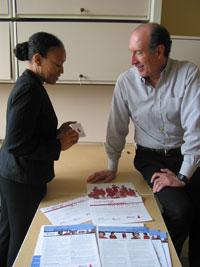
|
|
Dennis and a colleague review the popular Red Dress resources used in The Heart Truth campaign that raises awareness of heart health issues for women.
|
My career goals are pretty much realized after almost thirty years as a public health analyst. When people ask me if I plan to retire soon, I am obliged to point out that my father, at the age of 97, is still working full-time running the charter bus company he founded in college in 1929. Thus it would be unseemly for me to retire ahead of him.
My next career goal is to become what you might call a “Social Capitalist”. In preparation for this transition I have been developing for the past 8 years in my spare time a website start-up. I call it a “Social Fabric Cyber Loom”, designed to increase the quantity and quality of connections that individuals have with the other members of the various communities to which they belong.
|
|
5. When I'm not working, I like to...
|
Back to Top

|
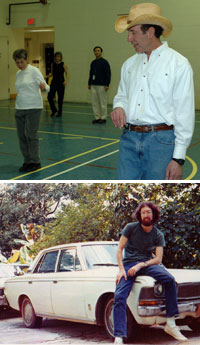
|
|
Dennis leads a line dance for other NIH employees in the campus gymnasium (top). Dennis sits on the hood of his car in San Juan, Puerto Rico, where he spent several years working for a public health program. His experiences prompted him to pursue a masters degree in health policy and management (bottom).
|
When I’m not working, I like to teach line dancing. I founded a Country Western Line Dance Club at NIH in 1995, which meets every Tuesday at noon in the NIH Clinical Center gymnasium. You can read an article about my classes in an NIH newsletter at http://nihrecord.od.nih.gov/newsletters/2006/04_07_2006/story03.htm. I use some of my program analyst skills to transcribe every dance that I wish to teach into a specially designed spreadsheet format with different rows and columns for the various aspects of the dance.
I am also interested in philanthropic activities, specifically, improving the operation of the Combined Federal Campaign (CFC) at NIH. I am currently designing a “cousin” program to the CFC, tentatively called “Health’s Angels” that will enable NIH employees to easily find and sign up for volunteer activities with non-profit organizations in our community.
|
|
|
|
 |